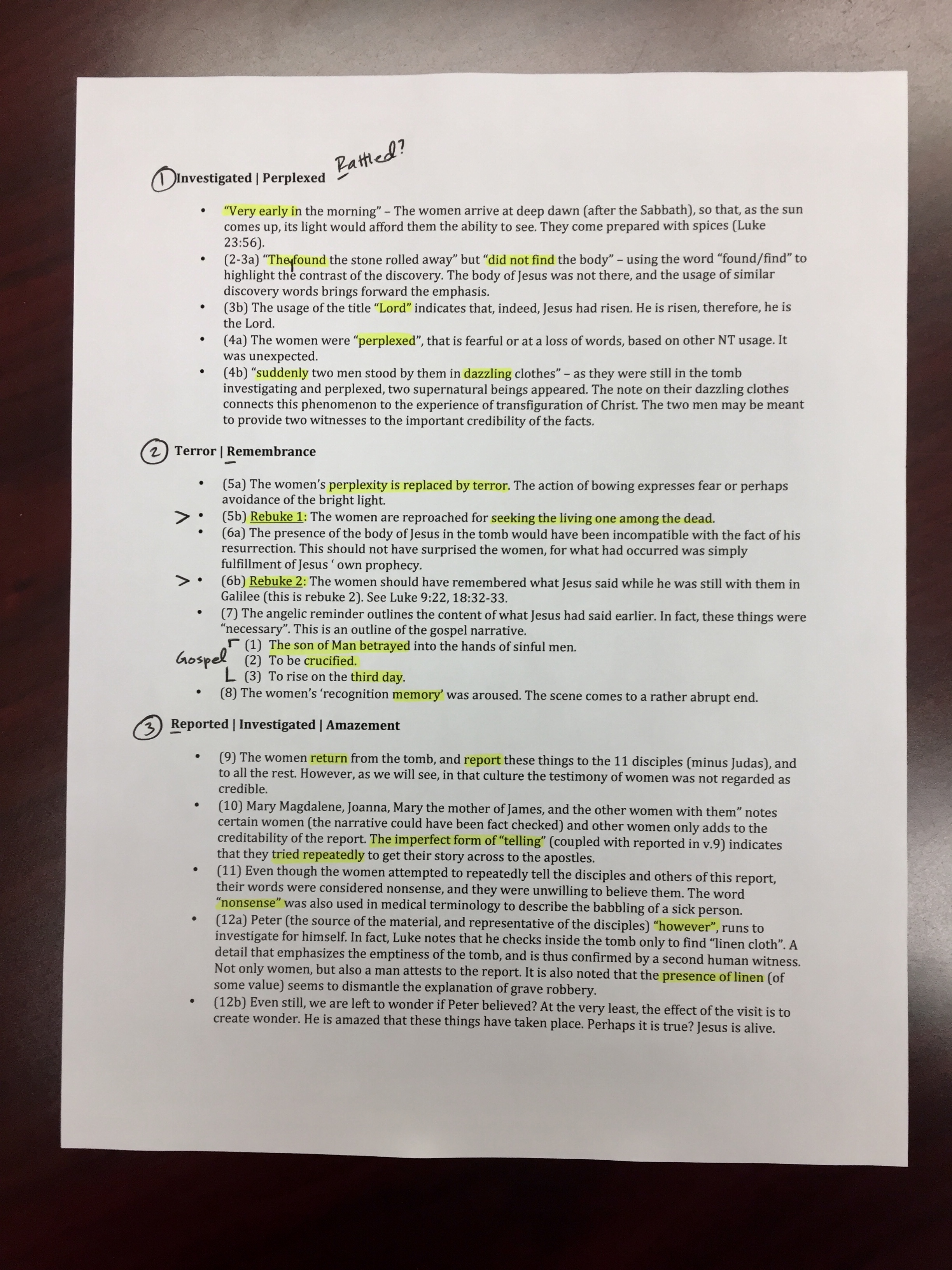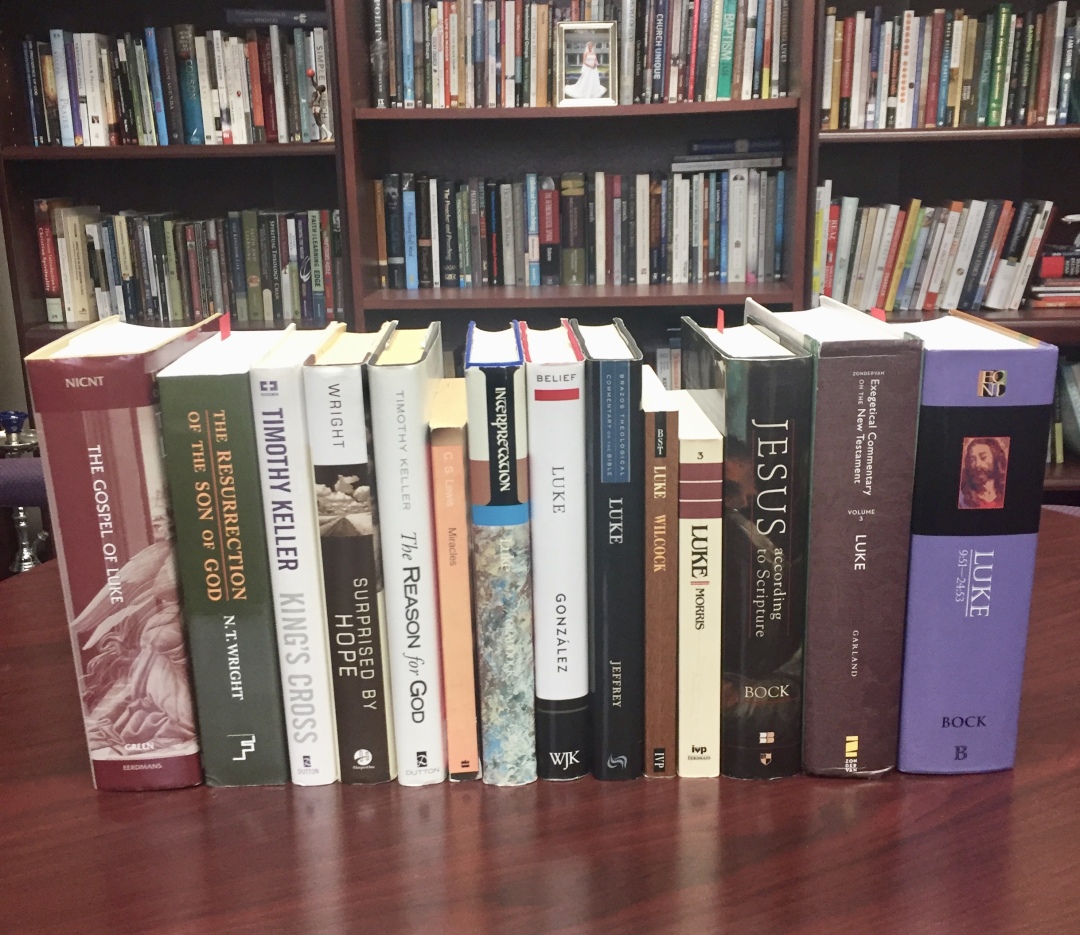Preparing a sermon week after week is a lot of work. Preaching a sermon week after week is also a pure joy. This past week I posted pictures of my sermon preparation process on Twitter, and several pastors and church leaders commented that it was helpful for them. I figured I would publish this blog post with a little explanation for each step.
Step 1: Examine The Text Itself

I typically plan my sermon text weeks or months ahead of time. This not only helps me plan and prepare adequately, it also allows our pastor for worship plan the entire service in light of the text.
Very early in the week I will prayerfully and attentively read the text several times, and ask questions of the text. I look for repeated words. I look for phrases or statements that need clarification or seemed to be emphasized by the writer. During this step, I typically use resources in the original languages in a very specific way, namely, to dig deeper on certain words or illuminate my understanding of certain phrases in the passage. My main goal is to understand what the text says as best I can.
Step 2: Divide The Text Into Units And Dig Deeper

Usually, the English translations of the Bible have helpful paragraph divisions that allow us to understand units of thoughts or movement in the narrative. Are there specific scenes or rational arguments that move the reader from point A to point B? If so, that is an indication of how one might break the sermon up into points? Commentaries are helpful at this step. The biblical scholars who write commentaries typically show how the text unit is divided in a literary sense.
At this step, I also read certain portions or commentaries in order to shape the language I use to explain the text. As for the use of commentaries, I try and read several scholarly hermeneutical commentaries, application-focused homiletical commentaries, and books related to the text or topic.
Step 3: Articulate The Main Point And The Subpoints Of The Sermon

I like to have the sermon outlined by Wednesday if possible. Not only does this lock me into a sermon structure, it also allows me to send the outline to the AV Team in order to produce the sermon points for Sunday as well as the Kids Director to produce the Kids Listening Guides.
The main point of the sermon is a sentence that I repeat several times throughout the sermon. In other words, when someone leaves after hearing the sermon – my goal is to have this point seared into their minds and hearts. The subpoints either serve as support of the main point or simply indicate movement in the narrative or argument of the text.
Step 4: Develop The Applications and Illustrations Of Each Subpoint

This past week, I used the application grid that has been produced by Mark Dever of 9 Marks Ministries. What I like about this application grid is that it forces me, as the preacher, to apply the text to the different groups of people that may be in the room.
For many pastors, application and illustration are the most difficult parts of sermon preparation. This portion of sermon preparation requires that you try and anticipate, as best you can, the thoughts, questions, struggles, and needs of your listeners. At this point, my goal is to press in and pray that God would provide conviction, comfort, or confidence in the listener.
I have also found it helpful to read or listen to living trusted preachers throughout the week while walking, driving or working in the yard. Often times, God uses other brothers to help clarify the explanation of the text or shape my own applications or illustrations.
Step 5: Write The Sermon In Its Entirety
I preach from a manuscript. This allows me to remain extremely focused as I preach. Therefore, I begin with my outline, and then work to clarify my explanation of the text. After these sections of the sermon are filled in, I then go back in and add the applications and illustrations. I do all of this, making sure that I restate the main point of the sermon in each section.
The last stage of preparation before printing and delivering the sermon is adding the introduction and conclusion. It is only after the completion of the body of the sermon that I am prepared to frame the sermon with initial and concluding thoughts. As an expository and theological preacher, my goal is to walk people through the biblical text in order that God’s word can be clearly understood. Where the Word of God is properly taught; when the Spirit of God opens the heart; the voice of God is properly heard.
I always ask, how many times will people hear the good news of the gospel during the service in its entirety? How many times will I proclaim the gospel and call for a response during my sermon? Could my sermon be preached as is, if Jesus did not rise from the grave? If not, my sermon is not distinctively Christian.
Step 6: Print And Preach

Once again, I write all of my sermons in manuscript/bullet point form. I typically shoot for 8-10 pages in size 12 font. When I print the sermon, I print it horizontally with two columns. This allows me to fold each page in half and punch holes for a 5-1/2 x 8-1/2 binder. I own one of these genuine leather sermon notebooks, and I love it.
Finally, before I preach, I humbly realize that all of my efforts are feeble unless God opens the hearts of the hearers under my voice. While I pray for clarity of thought and sensitivity to the Spirit throughout the preparation process, before the moment of preaching I pray that everyone within the sound of my voice will understand the text clearly, and be sensitive to the Spirit as He calls them to respond.
I am certainly no expert in preaching or sermon preparation. However, I have found this process helpful in the weekly ministry of preaching. Hopefully, you have found something here helpful. We all have our patterns and practices. If you are a pastor, how do you prepare? I would love to learn from you as well.
Here is the video of this particular sermon at Fairview Baptist Church in Apex, NC.










